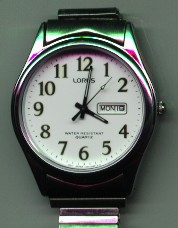Circular Dials
Today, just try to turn your back on the friendly face of an old clock. The University of Houston's College of Engineering presents this series about the machines that make our civilization run, and the people whose ingenuity created them.
I wear a digital watch, and I wake to a digital alarm clock. Does that mean circular clocks are dying out? Will I, one day, give up my old wall clock with its hands and a face?
Digital clocks usually have a more precise readout. It's easier for children to read them. Linear time -- time as a sequence of rising numbers -- that's pure simplicity. Of course it's simplicity the same way a tree is simpler than a forest.
A circular dial paints a picture of earth's rotation. It models our own experience of passing time. It's a lovely analog of reality. But, in a digital display, night never falls. Time simply advances, without features, minute after minute.
It's an odd competition. And I become a battleground where the practical simplicity and precision of my digital watch competes with the metaphorical imagery and visual grace of my clock.
So what do you think? Will your grandchildren grow up never reading an analog clock? We've left many other things behind this century -- Betamax, slide rules, dirigibles, LPs, autogyros.
So what has survived and why? Try silverware. We keep trying to improve knives, forks, and spoons. The runcible spoon, half fork/half spoon, was a cute idea. But where is it now, outside The Owl and Pussycat poem? It couldn't compete with the perfect balance and feel of the silverware we use. If we bend a fork just a hair out of its graceful alignment, it drives us nuts.
Radio didn't replace the quiet tactile newspaper. TV didn't replace radio, and the video phone has never caught on. We often don't want visual distraction. If I read Dylan Thomas:
This day winding down now
At God speeded summer's end
In the torrent salmon sun, ...
you don't want me to show you a picture of a sunset. You'd rather dream your own.
A clock face evokes its own abstract picture of this day winding down. Those clockwise-moving hands are a literal picture of the day winding on, because clock faces were made to mimic sundials. In the Northern hemisphere, a sundial shadow is an hour-hand moving in that same rotation.
If you want to predict the death or survival of a technology, you certainly ask if it's functional. But that's never enough by itself. You have to look beyond. You have to ask if it's a metaphor for something more than function. You have to ask how it lies against your skin and next to your soul. Once a technology has touched us in that deep visceral and emotional place, it'll find a way to persist -- from one generation to the next.
I'm John Lienhard, at the University of Houston, where we're interested in the way inventive minds work.
(Theme music)

Inwardly quartz-driven -- Outwardly the face of an old clockwork watch